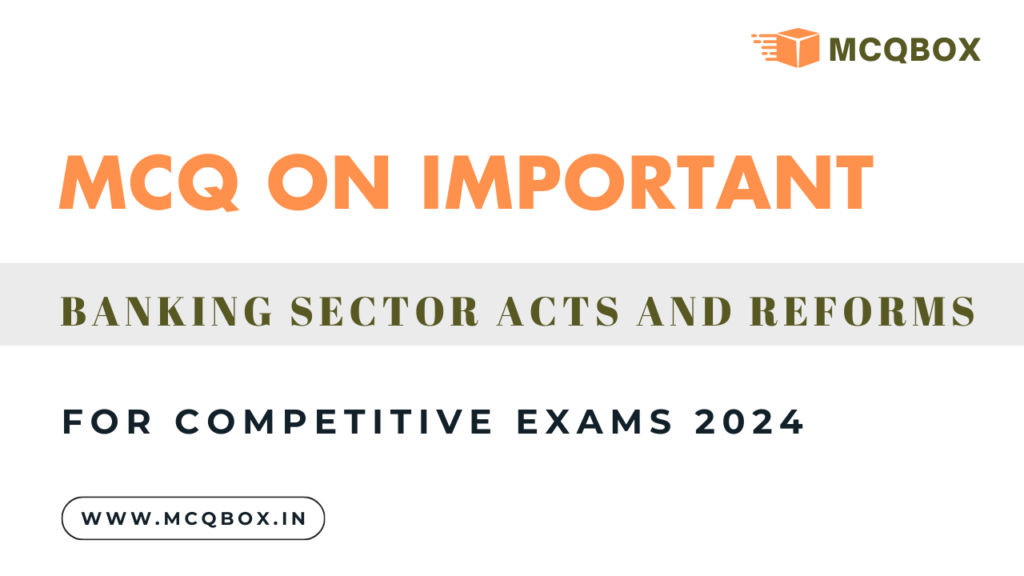Test your knowledge with this comprehensive MCQ on Important Banking Sector Acts and Reforms. Enhance your understanding and stay updated!

MCQ on Important Banking Sector Acts and Reforms
1. Which act established the Reserve Bank of India (RBI) as the central banking institution in India?
A) Negotiable Instruments Act, 1881
B) Banking Regulation Act, 1949
C) Reserve Bank of India Act, 1934
D) Prevention of Money Laundering Act, 2002
Answer: C) Reserve Bank of India Act, 1934
2. Which committee recommended measures to strengthen the banking system, including reducing government interference and increasing the role of the RBI in supervising banks?
A) Narsimha Committee II
B) H. Khan Committee
C) Raghuram Rajan Committee
D) PJ Nayak Committee
Answer: A) Narsimha Committee II
3. Which legislation provides a legal framework for negotiable instruments such as promissory notes, bills of exchange, and cheques?
A) Banking Regulation Act, 1949
B) Reserve Bank of India Act, 1934
C) Negotiable Instruments Act, 1881
D) Securitization and Reconstruction of Financial Assets and Enforcement of Security Interest (SARFAESI) Act, 2002
Answer: C) Negotiable Instruments Act, 1881
4. Which act aimed to prevent money laundering and terrorism financing, establishing the Financial Intelligence Unit (FIU)?
A) Prevention of Money Laundering Act, 2002
B) Insolvency and Bankruptcy Code (IBC), 2016
C) Foreign Exchange Management Act (FEMA), 1999
D) Securitization and Reconstruction of Financial Assets and Enforcement of Security Interest (SARFAESI) Act, 2002
Answer: A) Prevention of Money Laundering Act, 2002
5. Which committee was constituted to review the economic capital framework of the Reserve Bank of India?
A) Bimal Jalan Committee
B) HR Khan Committee
C) Indradhanush Framework
D) Nachiket Mor Committee
Answer: A) Bimal Jalan Committee
6. Which framework was introduced in 2018 to improve public sector banks (PSBs) in India, focusing on governance reforms, responsible banking, credit off-take, financial inclusion, and customer responsiveness?
A) Indradhanush Framework
B) 4R Framework
C) EASE (Enhanced Access and Service Excellence) Framework
D) Financial Sector Legislative Reforms Commission (FSLRC)
Answer: C) EASE (Enhanced Access and Service Excellence) Framework
7. Which act established the Reserve Bank of India (RBI) as the central banking institution in India?
a) Banking Regulation Act, 1949
b) Negotiable Instruments Act, 1881
c) Reserve Bank of India Act, 1934
d) Prevention of Money Laundering Act, 2002
Answer: c) Reserve Bank of India Act, 1934
8. Which legislation regulates and supervises the banking sector in India and empowers the RBI to regulate banks and their operations?
a) Banking Regulation Act, 1949
b) Insolvency and Bankruptcy Code, 2016
c) Securitization and Reconstruction of Financial Assets and Enforcement of Security Interest (SARFAESI) Act, 2002
d) Foreign Exchange Management Act (FEMA), 1999
Answer: a) Banking Regulation Act, 1949
9. Which committee recommended measures to strengthen the banking system in India, including reducing government interference and enhancing transparency?
a) H. Khan Committee
b) Raghuram Rajan Committee
c) Nachiket Mor Committee
d) Narasimham Committee I
Answer: d) Narasimham Committee I
10. The Insolvency and Bankruptcy Code (IBC), 2016, addresses insolvency and bankruptcy proceedings for which entities?
a) Only corporate entities
b) Only partnership firms
c) Only individuals
d) Individuals, partnership firms, and corporate entities
Answer: d) Individuals, partnership firms, and corporate entities
11. Which framework was introduced in 2015 to revitalize and reform public sector banks (PSBs) in India?
a) 4R Framework
b) Indradhanush Framework
c) EASE (Enhanced Access and Service Excellence) Framework
d) Bimal Jalan Committee Framework
Answer: b) Indradhanush Framework
12. Which act provides a legal framework for securitization and reconstruction of financial assets and enforcement of security interests, enabling banks to recover outstanding dues without court intervention?
a) Foreign Exchange Management Act (FEMA), 1999
b) Prevention of Money Laundering Act, 2002
c) Negotiable Instruments Act, 1881
d) Securitization and Reconstruction of Financial Assets and Enforcement of Security Interest (SARFAESI) Act, 2002
Answer: d) Securitization and Reconstruction of Financial Assets and Enforcement of Security Interest (SARFAESI) Act, 2002
13. Which committee was formed to review the economic capital framework of the Reserve Bank of India and recommended transferring a portion of RBI’s surplus reserves to the government?
a) HR Khan Committee
b) PJ Nayak Committee
c) Nachiket Mor Committee
d) Bimal Jalan Committee
Answer: d) Bimal Jalan Committee
14. Which committee emphasized the need for structural reforms, consolidation of the banking sector, and the establishment of strong and autonomous regulatory bodies?
a) Raghuram Rajan Committee
b) Nachiket Mor Committee
c) Narsimham Committee II
d) PJ Nayak Committee
Answer: c) Narsimham Committee II
15. Which act aims to prevent money laundering and the financing of terrorism, establishing the Financial Intelligence Unit (FIU) as the central agency for receiving, analyzing, and disseminating information related to suspicious transactions?
a) Negotiable Instruments Act, 1881
b) Prevention of Money Laundering Act, 2002
c) Foreign Exchange Management Act (FEMA), 1999
d) Insolvency and Bankruptcy Code (IBC), 2016
Answer: b) Prevention of Money Laundering Act, 2002